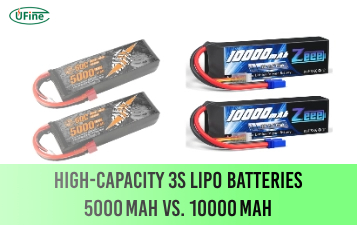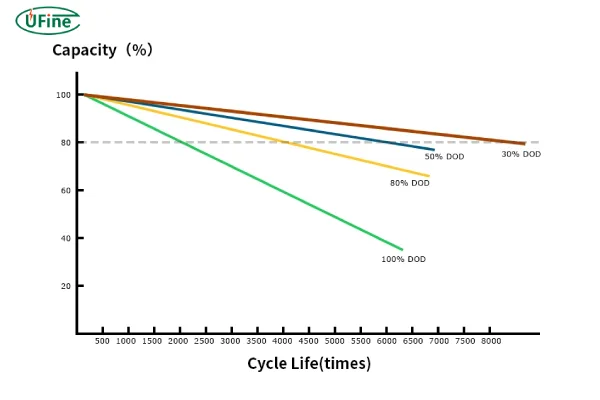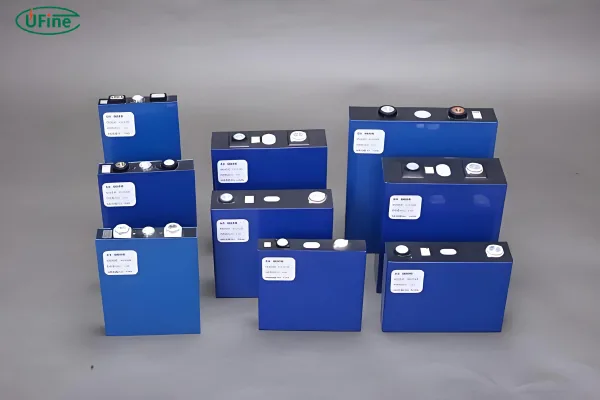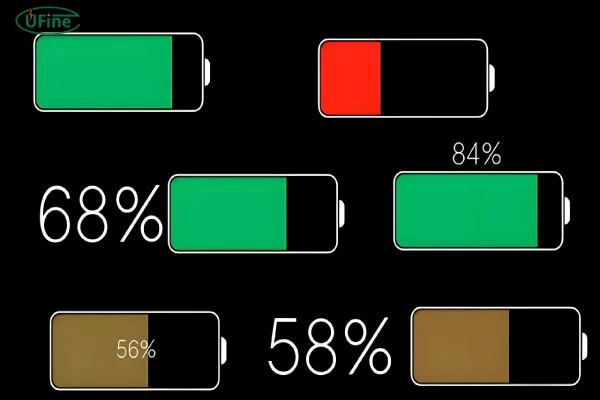Part 1. What affects LiFePO4 cycle life?
The charge and discharge cycle of the LiFePO4 battery is a complex physical and chemical reaction process, and its cycle life is affected by various factors.
1.Charge and discharge
When choosing a battery charger, it is best to use a charger with a correct termination device to cut off the charge, to avoid shortening the service life of the lithium iron phosphate battery due to overcharging. Generally speaking, slow charging can extend the battery’s life better than fast charging.
2. Discharge depth
The depth of discharge is the main factor affecting the LiFePO4 battery life. The higher the depth of discharge, the shorter the life of the lithium iron phosphate battery. In other words, as long as the depth of discharge is reduced, the service life of lithium iron phosphate batteries can be greatly extended. Therefore, over-discharging lithium battery UPS to extremely low voltages should be avoided.
3. Temperatures
If LiFePO4 batteries are used at high temperatures for a long time, their electrode activity will decay, and their service life will be shortened. Therefore, trying to maintain a suitable operating temperature is a good way to extend the LiFePO4 battery life.
Based on the above influencing factors, the following focuses on the impact of temperature on LiFePO4 cycle life.
Part 2. LiFePO4 life cycle in normal temperature
If a LiFePO4 battery is used normally, its cycle life is basically more than 2,000 times.
Stable charge and discharge at high C-rate
Most high-rate discharge applications are power lithium batteries, and most of them are used in applications that provide power to motors. Since most LiFePO4 batteries operate under high load conditions, the battery material decay time is accelerated, and the cycle life is also about 800 times.
Unstable charge and discharge at high C-rate
The LiFePO4 battery used in this case has a shorter lifespan, only about 300 times.
Part 3. LiFePO4 life cycle in high-temperature
The high-temperature performance of LiFePO4 batteries is not very mature at present, and the operating temperature is -20 °C to 125 °C. This temperature range is a theoretical value, and the actual application temperature range is smaller.
Small current charging and discharging
In this field of application, if LiFePO4 batteries are used normally if the battery brand manufacturer is relatively strong and of good quality, it will basically have a cycle life of more than 1,000 times; for small lithium battery manufacturers, the cycle life of slightly inferior quality will be 500 times. The cycle life is more than ten times because use at high temperatures will cause greater damage to the battery.
Stable charge and discharge at high C-rate
Since most LiFePO4 batteries operate under high load conditions, the battery material decay time is accelerated, and the LiFePO4 battery life is sharply reduced. Poor-quality batteries may only last about 300 cycles; strong battery brand manufacturers. With equipment, technology, and material application, it will be better, and the battery quality will be better, but the cycle life will only be about 500 times.
Unstable charge and discharge at high C-rate
Unstable operation at high temperatures and discharge rates will cause greater damage to the battery and lower cycle life. Tests of cells from several battery manufacturers found that after 250 to 300 times, the battery is basically unusable.
Part 4. LiFePO4 life cycle in low temperature
Low-temperature environments have a greater impact on the performance of LiFePO4 batteries than high temperatures. Judging from the current market situation, lithium iron phosphate batteries operate from below -20 °C to -40 °C, and their lifespan is significantly reduced, with a cycle life of 300 times.
Part 5. How to test LiFePO4 cycle life?
The cycle and service life of LiFePO4 batteries can be evaluated through a series of tests. Here are some commonly used testing methods:
Charge and discharge cycle test
This is one of the key tests to evaluate battery performance and life. In this test, the battery undergoes a series of charge and discharge cycles to simulate cyclic operation under actual use conditions. Cycling testing typically involves charging to a fully charged state and then discharging to a specified end-of-discharge voltage. Repeat this charge-discharge process multiple times to evaluate the performance stability of the battery over multiple cycles.
Capacity fading test
This test measures a battery’s capacity fade, which is the change in its ability to store and release energy over time. At the beginning of the test, the battery is charged to full charge and then discharged at a rate up to the battery’s termination voltage. Repeat this process multiple times and record the actual capacity of the battery after each cycle. By comparing the initial capacity with the capacity of subsequent cycles, the capacity fading of the battery can be evaluated.
Temperature performance test
Battery performance and life are also affected by ambient temperature. Temperature performance testing typically involves exposing the battery to different temperatures and performing charge and discharge tests. This can help determine battery performance and reliability under different temperature conditions.
Internal resistance test
The internal resistance of a battery is an important factor affecting its performance and life. Internal resistance testing can evaluate the size of the battery’s internal resistance. Common testing methods include AC impedance spectrum analysis, current pulse testing, etc.
Security performance testing
The safety performance of LiFePO4 batteries is very important. Safety performance tests include short circuit tests, overcharge tests, over-discharge tests, etc., to evaluate the safety and stability of the battery under abnormal conditions.
Extending the cycle life of a LiFePO4 (Lithium Iron Phosphate) battery involves optimizing its usage, charging, and storage practices. LiFePO4 batteries are already known for their long cycle life, but following these steps can help maximize their lifespan even further:
Part 6. How to extend the cycle life of LiFePO4?
1. Avoid Deep Discharges
- Discharge Depth: Try not to fully discharge the LiFePO4 battery. Keeping the State of Charge (SOC) between 20% and 80% helps extend its cycle life. Deep discharges below 20% can put extra strain on the battery, leading to a shorter life.
- Partial Cycling: Regularly performing shallow discharge cycles (e.g., using only 30-50% of the battery’s capacity) is better for battery health than deep cycling.
2. Optimal Charging Practices
- Avoid Overcharging: Do not charge the battery to 100% capacity frequently unless necessary. Charging up to 80-90% can significantly prolong the life of LiFePO4 cells.
- Use a Quality Charger: Ensure the charger is designed specifically for LiFePO4 batteries. It should include protections like overcharge protection, overcurrent protection, and temperature monitoring.
- Moderate Charging Current: Avoid charging the battery at very high currents, as it can cause stress on the cells. Charging at 0.5C to 1C (C-rate refers to the current relative to the battery capacity) is generally safe for LiFePO4 batteries.
- Temperature-Controlled Charging: Charge the battery in a temperature range between 0°C and 45°C (32°F to 113°F). Charging outside this range can damage the battery.
3. Temperature Management
- Avoid Extreme Temperatures: LiFePO4 batteries perform best when kept in a temperature range between 10°C and 35°C (50°F to 95°F). Exposure to extreme heat or cold can accelerate battery degradation.
- Storage Temperature: If you plan to store the battery for an extended period, store it in a cool, dry place at around 50% SOC and at temperatures between -10°C and 25°C (14°F to 77°F) to minimize self-discharge and extend its cycle life.
- Ventilation: Ensure that the battery pack is well-ventilated and kept cool during use, especially in high-drain applications like electric vehicles or solar energy systems.
4. Avoid High Discharge Currents
- Moderate Discharge Rates: Refrain from discharging LiFePO4 batteries at excessively high rates. Keeping the discharge current within the recommended limits (usually 1C to 3C) will help reduce the internal stress on the cells and extend their lifespan.
- Smart Battery Management System (BMS): Use a good-quality BMS that monitors and regulates charge, discharge, temperature, and voltage across the cells to prevent excessive current draw or thermal runaway.
5. Storage Recommendations
- Storage SOC: If you’re not using the battery for an extended period, store it at around 40-50% charge. Storing a LiFePO4 battery fully charged or completely discharged can degrade its capacity over time.
- Avoid Long Storage Without Use: LiFePO4 batteries can lose capacity if left unused for extended periods. If possible, occasionally cycle the battery during long-term storage to keep it healthy.
6. Balancing the Cells
- Cell Balancing: Over time, the individual cells in a LiFePO4 battery pack can become imbalanced, with some cells having higher voltages than others. A battery management system (BMS) with cell balancing can ensure that each cell is evenly charged and discharged, preventing overvoltage in some cells and under-voltage in others, which can shorten the battery’s life.
- Periodic Equalization: Some chargers have an “equalization” function, which can help balance the charge across all cells in the battery. Periodically running this process can help prevent imbalance and prolong the battery’s life.
7. Use Proper Battery Maintenance Tools
- BMS Monitoring: A BMS continuously monitors battery parameters like voltage, current, temperature, and SOC to ensure the battery operates within safe conditions. Regular monitoring via the BMS can help identify potential issues early.
- Data Logging: Some advanced systems allow for data logging, which can give insights into the battery’s health over time and highlight any misuse or problems.
8. Avoid Prolonged High Power Demands
- High-Drain Applications: If possible, limit the battery’s use in very high-drain applications, or ensure that the battery is well-suited to handle such loads. Using batteries outside their intended discharge rating can accelerate wear and tear.
9. Use Smart Inverters and Controllers
- In Solar Applications: If you’re using LiFePO4 batteries in solar or renewable energy setups, ensure that the inverter and charge controllers are configured for LiFePO4 chemistry. This will optimize charging efficiency and protect the battery from overcharging or undercharging.
Part 7. FAQs
-
What is the lifespan of a LiFePO4 battery?
The lifespan of a LiFePO4 battery can range from 2000 to 5000 cycles, depending on factors like depth of discharge, charging methods, and operating conditions. -
Can LiFePO4 batteries last 20 years?
While LiFePO4 batteries have a long lifespan, achieving 20 years would require favorable usage patterns, proper maintenance, and optimal operating conditions. -
How many cycles does a LiFePO4 have?
LiFePO4 batteries typically have a cycle life ranging from 2000 to 5000 cycles, depending on factors such as depth of discharge, charging protocols, and environmental conditions. -
Is LiFePO4 better than lithium-ion cycle life?
LiFePO4 batteries generally offer better cycle life than traditional lithium-ion batteries due to their more stable chemistry and robust construction. -
Does LiFePO4 Battery Cycle Life Matter?
Yes, the cycle life of a LiFePO4 battery is an important consideration as it determines the number of charge and discharge cycles it can undergo before experiencing significant capacity loss.
Related Tags:
More Articles

High‑Capacity 3S LiPo Batteries: 5000 mAh vs. 10000 mAh
Compare 3S LiPo 5000mAh vs 10000mAh batteries by weight, power, and use. Find the best fit for your drone, RC car, or boat setup.
Top 5 Applications for Small 3S LiPo Batteries
Small 3S LiPo batteries power drones, RC gear, wearables, and robotics with high energy and low weight. Making them ideal for compact electronics projects.
Building and Charging Your Own 3S LiPo Pack: A Step‑by‑Step Guide
Learn how to build, balance, and charge a 3S LiPo battery pack safely at home with this complete DIY guide for hobbyists and beginners.
How to Choose the Right LiPo Battery Plug Type?
Discover the best LiPo battery plug types, how to choose them, and expert tips for safe usage, soldering, and maintenance.
Choosing the Right Connector for Your 3S LiPo Battery
Choosing the right 3S LiPo connector depends on current, space, and use. Learn the pros and cons of XT60, JST, EC3, and more.







